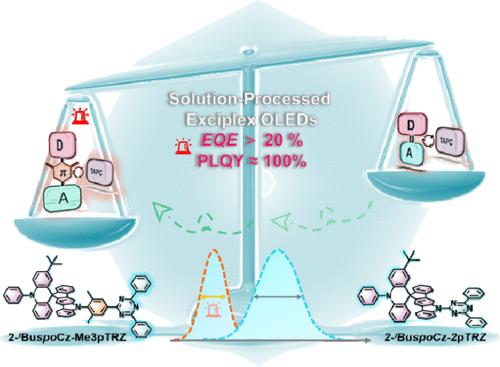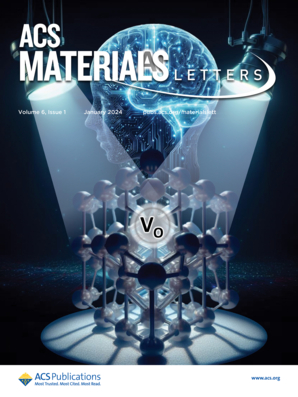HLCT 发射器的新概念:用于高效和极低效率滚降溶液加工型有机发光二极管的复合系统中的受体分子
IF 9.6
1区 化学
Q1 MATERIALS SCIENCE, MULTIDISCIPLINARY
引用次数: 0
摘要
尽管杂化局域和电荷转移(HLCT)发射体分子可以收集单线和三线激子,但在激元系统中使用杂化局域和电荷转移(HLCT)发射体作为受体或供体分子仍然是一个新概念。本文制备了两种 HLCT 发射器,即 2-tBuspoCz-2pTrz 和 2-tBuspoCz-Me3pTrz,作为具有热激活延迟荧光(TADF)特性的赋形剂的受体。由 HLCT 和 TAPC 分子混合构建的赋形剂 TADF 系统在单线激发态和三线激发态之间具有微小的能隙,且发射效率相同。使用该复合物作为发射体,溶液处理装置的最大外部量子效率(EQEmax)达到 16.6%。令人印象深刻的是,以制备的赋形剂为宿主的溶液加工器件显示出极低的开启电压和有望达到 20% 的 EQEmax,同时在 1,000 cd m-2 时具有 0.5% 的极低效率衰减。这项研究探索了 HLCT 发射器作为赋形剂受体的潜力,并为高效赋形剂系统的设计提供了指导。本文章由计算机程序翻译,如有差异,请以英文原文为准。

New Concept for HLCT Emitter: Acceptor Molecule in Exciplex System for Highly Efficient and Extremely Low-Efficiency Roll-Off Solution-Processed OLED
The use of hybridized local and charge-transfer (HLCT) emitters as acceptor or donor molecules in exciplex systems is still a novel concept even though HLCT molecules can harvest both singlet and triplet excitons. Herein, two HLCT emitters, 2-tBuspoCz-2pTrz and 2-tBuspoCz-Me3pTrz, are prepared as acceptors of exciplexes with thermally activated delayed fluorescence (TADF) properties. The exciplex TADF systems constructed by mixing HLCT and TAPC molecules have a minute energy gap between singlet and triplet excited states and unity emission efficiency. Using the exciplex as an emitter, solution-processed devices achieve maximum external quantum efficiency (EQEmax) of 16.6%. Impressively, solution-processed devices with the fabricated exciplexes as hosts exhibit extremely low turn-on voltages and a promising EQEmax of >20%, which is concomitant with an extremely low-efficiency roll-off of 0.5% at 1,000 cd m–2. This study explores the potential of HLCT emitters as acceptors of exciplexes and guides the design of efficient exciplex systems.
求助全文
通过发布文献求助,成功后即可免费获取论文全文。
去求助
来源期刊

ACS Materials Letters
MATERIALS SCIENCE, MULTIDISCIPLINARY-
CiteScore
14.60
自引率
3.50%
发文量
261
期刊介绍:
ACS Materials Letters is a journal that publishes high-quality and urgent papers at the forefront of fundamental and applied research in the field of materials science. It aims to bridge the gap between materials and other disciplines such as chemistry, engineering, and biology. The journal encourages multidisciplinary and innovative research that addresses global challenges. Papers submitted to ACS Materials Letters should clearly demonstrate the need for rapid disclosure of key results. The journal is interested in various areas including the design, synthesis, characterization, and evaluation of emerging materials, understanding the relationships between structure, property, and performance, as well as developing materials for applications in energy, environment, biomedical, electronics, and catalysis. The journal has a 2-year impact factor of 11.4 and is dedicated to publishing transformative materials research with fast processing times. The editors and staff of ACS Materials Letters actively participate in major scientific conferences and engage closely with readers and authors. The journal also maintains an active presence on social media to provide authors with greater visibility.
 求助内容:
求助内容: 应助结果提醒方式:
应助结果提醒方式:


